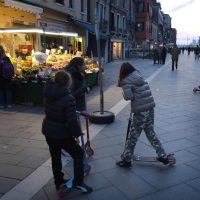Street Photography techniques
Let’s take a look at two very different Street Photography techniques needed for capturing great photographs in the street. One of these methods involves a degree of premeditation and planning. The other technique puts to use the most basic requirements for any street photographer – awareness and quick responses.
Both the photographs below were taken in Venice during one of the photography holidays I organised there until quite recently. Each situation required a very different approach in photo technique.
I reckon Venice is among the best places in the world for a photographer to find out if he, or she, really has an aptitude for street photography. Come on – if you don’t enjoy capturing pictures in Venice then maybe you’d be better looking at landscape or some other branch of photography.
Spotting that picture possibility

To illustrate the first of our two Street Photography techniques here’s a picture taken near the Arsenale – the historic naval dockyards of Venice. The whole place is still in use and it is common to see naval officers in their stylish Italian Navy uniforms coming and going along the quays beneath some splendid buildings.
I had spotted the likelihood of a picture using this particular building as a background some days before this photograph was taken. Fine, but a good background needs a good subject in the foreground. The naval officers were an obvious choice.
Planning the picture ‘trap’
The first decision with a premeditated picture like this is to decide the best time to capture it. In this case, morning was no use because the light was behind the building. As I wanted to emphasise the colour of the building, I knew it was best to be in position in the early evening. That was when the sun would be on the wall. Also, this has had the added bonus of casting a shadow from an ornate street lamp (out of shot) onto the wall to add an interesting detail.
The next step was to wait for the key subject. This proved less easy that I expected, and it took two evening visits before a suitable one made an appearance.
Then the important thing was the timing of the picture itself. When photographing people walking it is essential, in most cases, to ensure that the subject’s legs are seen to be striding out. This is easy enough, but it does take a little practise. It is just too easy to make a walking person look as if they are stood on one leg. Therefore, do not press the shutter out of sync with the person’s strides.
The alert street photographer always wins

My second photograph of Venice was the result of an immediate response to something that happened without the slightest warning. This photograph is a good example of the need for a street photographer to be alert and aware of what is happening around him.
Like any photographer in Venice I am captivated by the views down the canals between the old decaying palaces. I was looking down this canal with my camera around my neck but not held in my hands.
Then the window on my left was opened suddenly and the woman stepped out onto the tiny balcony. She banged those trainers together just twice to remove the dirt off them. Within seconds she had disappeared back inside the house.
It was time enough to raise my camera and get just one shot.
Camera at the ready – always
Had my camera been over my shoulder – or, even worse, in my camera bag – I would not have caught this picture. Therefore, a picture that illustrates that Venice is not just a showcase of old, damp palaces, but a place where ordinary people actually live, would have been missed.
Two tips for better street photography techniques
- Plan ahead, and consider picture possibilities based on a background – then wait for the subject.
- Always have you camera readily to hand and be aware of what is happening around you.


